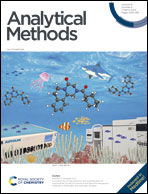Ultra-sensitive fluorescent detection of strychnine based on carbon dot self-assembled gold nanocage sensing probe†
Abstract
The ultra-sensitive detection of strychnine is crucial to provide powerful evidence in strychnine poisoning cases. In this study, a novel fluorescent carbon dots (CDs) self-assembled gold nanocage (AuNCs) composite is synthesized for the ultra-sensitive detection of strychnine using molecularly imprinted polymer sensing technology (MIPs-CDs@AuNCs). With strong loading and delivery capability of AuNCs, the CDs could be loaded into AuNCs, where the anisotropy of CDs could significantly decrease and the fluorescence of the MIPs-CDs@AuNCs probe gained lower relative standard deviation (RSD). Moreover, the fluorescence response of MIPs-CDs@AuNCs to target strychnine was observed to be more significant than MIPs-CDs without gold nanocages. Under optimal conditions, the developed MIPs-CDs@AuNCs fluorescence strategy showed good linear relationship at the concentration of strychnine from 3 ng mL−1 to 200 ng mL−1 with the limit of detection as low as 1 ng mL−1. Besides, real blood samples were analyzed without complex pre-preparation procedure to investigate the performance of the proposed molecularly imprinted fluorescence probe, and satisfactory results were obtained with absolute deviations between −1.16 ng mL−1 and 1.28 ng mL−1, which exhibited a great potential for the detection of strychnine in health care work.



 Please wait while we load your content...
Please wait while we load your content...